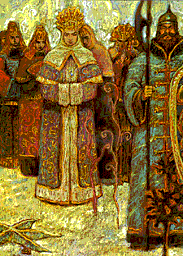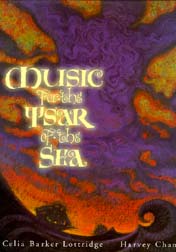|
________________
CM . . . .
Volume V Number 7 . . . . November 27, 1998
excerpt: Long ago in the city of Novgorod there lived a young man called Sadko who was very poor in everything but music. For Sadko's father had died leaving him nothing but an old gusli, a little harp made of maple wood. Sadko learned to play upon the gusli so well that he was called Sadko the minstrel.  In this Russian wonder tale retold by Lottridge, Sadko makes a subsistence
living from playing his harp and singing at the feasts of rich merchants. When,
over a three day period, Sadko does not get to entertain at any feasts, he goes
outside the walls of Novgorod and plays his harp by the shore of Lake Ilmen.
Each day, as he plays and sings, the waters of the lake become increasingly
turbulent until, on the third day, "the Tsar of the Sea, ruler of oceans and
seas," emerges from the lake and tells Sadko that he has greatly enjoyed his
playing and now wants to reward him. Sadko is to "cast a net into these waters
and whatever comes into it is my gift to you." However, Sadko is to promise
the Tsar of the Sea that he "will come to my palace under the sea and play for
me there." Sadko agrees, and his net casting yields a wooden chest filled with
jewels. Using his new wealth to establish himself as a businessman, Sadko now
appears at the feasts as Sadko the merchant, not Sadko the minstrel.
In this Russian wonder tale retold by Lottridge, Sadko makes a subsistence
living from playing his harp and singing at the feasts of rich merchants. When,
over a three day period, Sadko does not get to entertain at any feasts, he goes
outside the walls of Novgorod and plays his harp by the shore of Lake Ilmen.
Each day, as he plays and sings, the waters of the lake become increasingly
turbulent until, on the third day, "the Tsar of the Sea, ruler of oceans and
seas," emerges from the lake and tells Sadko that he has greatly enjoyed his
playing and now wants to reward him. Sadko is to "cast a net into these waters
and whatever comes into it is my gift to you." However, Sadko is to promise
the Tsar of the Sea that he "will come to my palace under the sea and play for
me there." Sadko agrees, and his net casting yields a wooden chest filled with
jewels. Using his new wealth to establish himself as a businessman, Sadko now
appears at the feasts as Sadko the merchant, not Sadko the minstrel.
A dozen years later, while Sadko is accompanying one of his trading ships across the Caspian Sea, the vessel is stopped, and no amount of sail will cause it to move. The crew recognize that "the Tsar of the Sea wants someone on this ship." Their tests identify that the sought after person is Sadko, who, recalling his promise, dives overboard. In the Tsar's underwater palace, Sadko plays and sings, but the Tsar's dancing creates giant storms on the sea which threaten to destroy all the ships. One of the Tsar's daughters, Volkova, who has been charmed by Sadko, suggests a clever scheme which will stop both her father's destructive storms and allow Sadko to return to Novgorod, supposedly to replace his harp strings. While the Tsar agrees to release Sadko, the minstrel must take one of the Tsar's daughters with him to ensure his return. Sadko selects Volkova who wants to remain with him, but she cannot exist "in the bright world above" and becomes the river which now flows next to Novgorod. Though Sadko remained a merchant, he still played his harp beside the Volkov River, and the Tsar danced gently to the music which wafted quietly to him from so far away. The motif of promises made and forgotten is found throughout the world's folk literature, and Music for the Tsar of the Sea is a most worthy addition to libraries' collections of such tales. Lottridge's rendering reads well orally and should become part of storytime sessions. Chan's full-page pastel illustrations, in rich, dark earth and water tones, face the text pages. As well, Chan has added sepia-coloured charcoal drawings to many of the text pages plus two sculptures which are found on the book's title and closing copyright pages. Music for the Tsar of the Sea was nominated for a Governor-General's Literary Award in the Children's Literature-Illustration category. Highly recommended. Dave Jenkinson teaches courses in childrens and young adult literature in the Faculty of Education, the University of Manitoba.
To comment on this title or
this review, send mail to cm@umanitoba.ca.
Copyright © the Manitoba Library Association.
Reproduction for personal use is permitted only if this copyright notice
is maintained. Any other reproduction is prohibited without
permission.
Published by
TABLE OF CONTENTS FOR THIS ISSUE - NOVEMBER 27, 1998.
AUTHORS |
TITLES |
MEDIA REVIEWS |
PROFILES |
BACK ISSUES |
SEARCH |
CMARCHIVE |
HOME
|

